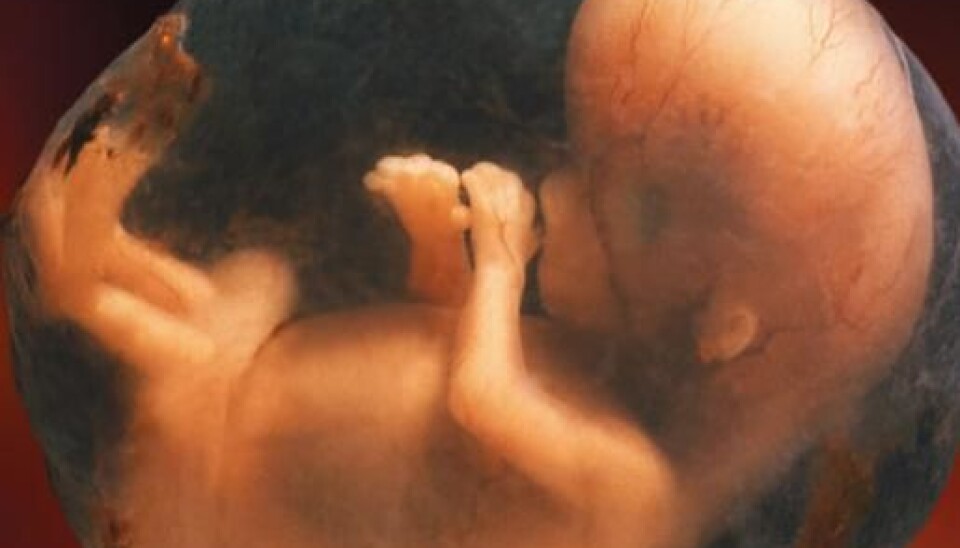
Umbilical cord defect risks assessed
Researchers at Bergen’s Haukeland University Hospital have found factors that increase the risk of abnormal umbilical cord connections. These in turn increase the risk of birth defects or stillbirths.
Denne artikkelen er over ti år gammel og kan inneholde utdatert informasjon.
If you're a woman over the age of 35, or are having your first baby, or have conceived using assisted reproductive technology (ART), or are having twins, you are at higher risk of developing an abnormal umbilical cord connection with the placenta.
A new study by the Department of Gynaecology and Obstetrics of the Haukeland University Hospital in Bergen also shows that pregnant women who have had umbilical cord attachment problems in previous pregnancies are more likely to have the same problem again.
Chances also increase if the foetus is a female. This is also a new discovery.
“During an ultrasound examination that is offered to all women [in Norway] during the second trimester, it’s easy to check whether the cord insertion is normal,” says Chief Physician and researcher Cathrine Ebbing of the Department of Gynaecology and Obstetrics at Haukeland.

“Now that we have identified the pregnancies that are most at risk, we can offer dedicated examinations to these women.”
Not part of routine check-ups
The new study, led by Ebbing, is the largest of its kind. The Medical Birth Registry of Norway was used to chart the health developments of more than 630,000 pregnant Norwegian women.
“A check-up of umbilical cord insertion is not currently a routine part of an ultrasound examination. We haven’t known which women were in the risk zone,” says Ebbing.
It’s no problem for midwives and doctors who are conducting the ultrasound to check out the umbilical cord connection to the placenta. Ebbing says this is neither time-consuming nor particularly difficult.
“I would certainly examine the connection of the umbilical cord to the placenta of women who falls into one of the risk populations identified by our study.”
“I’d also include those who have chronic illnesses such as diabetes and high blood pressure,” she said.
Higher with twins
Although the condition is reasonably easy to detect, there is no treatment for abnormal umbilical cord insertions.
“What we can do is monitor the development of the pregnancy closely and make careful plans for the delivery, to avert a serious outcome as much as possible,” says Ebbing.
More than 60,000 children are born in Norway annually. Researchers have charted pregnancies in which the umbilical was connected to the foetal membranes (called velamentous cord insertions), or to the side of the placenta rather than the centre (called marginal insertions).
From 1999-2009, 7.8 percent of all pregnant women carrying a single foetus had these kinds of abnormal insertions. Among those carrying twins, the share of abnormal cord insertions was 16.9 percent.
A velamentous insertion poses a larger risk of a stillborn birth if the child is born on schedule at around nine months.
The researchers also discovered that an abnormal insertion increases the risk of birth defects, a placental abruption (in which the placenta loosens from the uterine wall) and preeclampsia (high blood pressure and protein in the urine of the mother).
Lacking insulation
“The placenta is normally about as thick as an American pizza, with the umbilical cord inserted right in the centre of the pizza,” Ebbing explains.
“An abnormal insertion will be on the periphery. If the umbilical cord is attached to the foetal membrane, for example, the arteries in the umbilical are be more exposed to pressure and damage because they are not protected by as much insulation,” as in a normal insertion, she said.
In the worst case, the arteries can be punctured and the foetus risks bleeding to death.
The overall risk remains low
However, the risk of a miscarriage of stillborn birth remains quite low in Norway. Less than one percent of all infants in Norway die before, during or immediately after birth.
“Nevertheless, these kinds of deaths are really tragic. I have experienced this kind of catastrophe in the delivery room, where the umbilical was not attached correctly and the infant died.”
“There are other conditions that pose less of a risk than abnormal umbilical insertions, such as gestational diabetes, where the health services have invested a lot of resources to reduce the risk for the mother and child,” says Ebbing.
New studies, ethical challenges
Ebbing is unsure about the possible clinical consequences of this new study, such as the inclusion of an umbilical insertion check-up during routine ultrasounds, unless the expectant mother specifically requests it.
“We’ve investigated risk factors and whether these particular conditions entail risks, which they do. But we haven’t shown that it helps to know about the condition prior to a birth,” says Ebbing.
Finding the answer to that question would require more than a large study.
“It would also pose an ethical challenge if we were to randomise people in risk groups and give some of them an examination while refraining from examining the control group. I’d like to look into how knowing about this condition early on affects the mother and her decision making, but that sort of study isn’t currently on the cards,” she says.
“But we can say that our study has provided new awareness. Targeted examinations of women in the risk groups does us allow us to easily find out which have abnormal umbilical cord insertions.”
Read the Norwegian version of this article at forskning.no






























